|
Obsolete Outboards |

|
| by
Max Wawrzyniak - St Louis, Missouri - USA
Winterizing |
 |
I am going to take a break from the
series of columns on the 1956
Johnson 15hp to talk (write?) about a
timely subject, at least for those of us living in
the upper latitudes of the Northern Hemisphere: winter.
It is just about time to "winterize" outboard
motors to prevent damage during freezing weather.
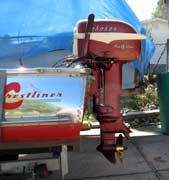 |
During
freezing weather, it is important that
outboards be tilted "down" so
that cooling water can fully drain. This
is true for an outboard on a boat kept
afloat and also for an outboard stored
"land side."
(click
images to enlarge) |
|
Most outboard motors are water-cooled,
drawing water from whatever the boat is floating in
(ocean, lake, river, etc.) circulating the water through
passages (water jackets) in the powerhead, and then
dumping the now-warmed water back into the ocean/lake/river/etc.
Such a cooling system can not, of course, be protected
from freezing temperatures by antifreeze as an auto's
engine can. All post 1950 water-cooled outboard motors
that I am aware of are designed so that the water
jackets will drain by themselves (no help needed from
you) when the engine is not running, as long as the
engine is in a vertical attitude (i.e. tilted "down").
Usually if one's boat is kept in the water, it is
better to "tilt-up" the outboard motor out
of the water so that seaweed, slime, barnacles and
other water critters will not attach themselves to
the bottom end of the outboard, In freezing weather,
however, one must always leave the outboard tilted
down so that the water will drain from the waterjackets.
If water is allowed to freeze in the waterjackets
if is possible that the cylinder block can crack,
resulting in an expensive repair to a newer outboard,
and probably reducing an old outboard to "parts
motor" status.
If your outboard is stored out of the water, either
on the transom of your boat or on a stand in the garage,
it is still important that it be stored in an upright
position. If that is just not possible, then at least
arrange for the motor to be upright for several minutes
to allow the water to fully drain from the passages
before it is placed in a horizontal position.
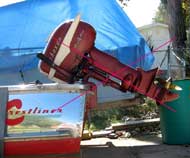 Leaving
an outboard tilted up during the winter
is asking for trouble. a water-cooled outboard
will probably have water trapped in cooling
passages, and a modern outboard with "through-hub"
exhaust may suffer a cracked lower unit
housing due to rain and snow collecting
in the exhaust cavity in the lower unit
and freezing. Leaving
an outboard tilted up during the winter
is asking for trouble. a water-cooled outboard
will probably have water trapped in cooling
passages, and a modern outboard with "through-hub"
exhaust may suffer a cracked lower unit
housing due to rain and snow collecting
in the exhaust cavity in the lower unit
and freezing. |
|
Those with more modern outboards that
feature "through-hub-exhaust;" (i.e. the
engine exhaust exits the engine through the propeller
hub) have another concern. If the motor is left attached
to the boat and is tilted-up, and if the boat is out
in the weather, it is possible for rain and snow to
pass through the open propeller hub and to collect
in the exhaust cavity at the rear of the lower unit,
where it can freeze and possibly crack the lower unit
housing. It is doubly important that outboards with
through-hub-exhaust be tilted down during freezing
weather
The next area of concern is the lower unit. Bad seals
may have allowed water to leak into the lower unit
gear case I have already laid out my opinions on leaky
seals in the lower units
columns so I will not address correcting
that problem here. What I will stress is that is it
very important that the lower units on ALL (new or
old) outboard motors be drained and refilled with
fresh lubricant before the onset of freezing weather.
Just because your outboard showed no signs previously
of water leaking into the lower unit does not mean
that there is not water in there now. In addition
to freezing and cracking the lower unit housing, water
in the lower unit can corrode the plain steel gears
and shafts and destroy the lubricating qualities of
the lower unit oil.
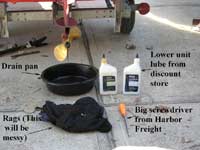 Changing
the lower unit lube prior to the onset of
freezing weather is a simple job ANYONE
can do; instructions were posted in the
"lower Units" columns. Just have
plenty of rags or paper towells handy; there
is almost no way to do this job without Changing
the lower unit lube prior to the onset of
freezing weather is a simple job ANYONE
can do; instructions were posted in the
"lower Units" columns. Just have
plenty of rags or paper towells handy; there
is almost no way to do this job without
making an oily mess. I use discount store
lower unit lube but if your engine is much
newer you should check the manufacturer's
recommendations. |
|
Often people will remove the drain
and vent plugs on the lower unit and walk away, leaving
the lower unit to drain and lay empty all winter.
This is an invitation to corrosion of the gears and
shafts, and of the ball/roller bearings in those engines
so equiped. Drain the old lube, checking for signs
of water. Water will either run out seperately, and
look like water, or it may have combined with the
lube, froming a "milkshake" like mixture.
After the old lube has fully drained, refill the lower
unit with fresh lube. If your engine is fairely new
(1970's or newer) or is one of those funky 1960's/1970's
OMC's (Johnson & Evinrude) fitted with electric
shift or electro-hydraulic shift, then you need to
be picky about what kind of lube you use in the lower
unit, and I suggest following the manufacturer's recommendations.
For the rest of the 1950's and 1960's OMC engines,
I always use the "store brand" lower unit
oil sold by a large chain of discount stores founded
by a guy named Sam. And since the lower units on most
of the 1950's outboards that I run mostly all leak
to one degree or another, I am in the habit of changing
the lower unit oil a few times during the boating
season.
Instructions on changing lower unit oil can be found
in the lower units columns and it is a simple, albeit
messy job.
| If the old
lube draining out looks a lot like your
new lube, your lower unit probably does
not leak. Water can either collect at the
bottom of the lower unit, and drain out
looking just like water, or..... |

|
|
If your lower unit uses grease (such as the Lubriplate
105 that I have recommended
in the past), you are not going to be able to easily
change the lower unit lube. With these engines, I
usually remove the drain/vent plugs and allow the
engines to sit a few days, occasionally turning the
flywheel so that the lower unit gears rotate some,
and most of the water (if there is any) will drain.
I will then "top-off" the grease in the
lower unit and re-install the drain/vent plugs.
The next item on the winterizing list is usually "fogging"
the engine. This usually means spraying an aerosol
"fogging Oil" (sold as such) into the spark
plug holes and then rotating the engine to distribute
the oil around the cylinders. A better plan, but more
difficult to accomplish, is to spray the fogging oil
into the carburetor air intake as one "runs the
gas out" of the engine. And then spray it in
through the spark plug holes.
 |
... water
can combine with the lube forming a "milk
shake" of contaminated lube.
|
|
I do not fog my engines. With a late model engine
running on lean oil/ gasoline mixtures, the fogging
oil is needed to protect the internal parts of the
engine from corrosion. My old outboards carry 24 to
1 oil mixture recommendations from the factory, and
I usually run them "richer," mixing the
oil and gasoline at about 16 to 1. An outboard motor
run on 16 to 1 is already pretty-well "fogged"
in my opinion, so I don't see the need to inject even
more oil into the thing.
Back in the mid-1980's, some OMC outboards came from
the factory labeled for 100 to 1 oil/gas mixtures.
OMC later altered this recommendation to 50 to 1 (which
is what you should be running if you have one of these
engines.) The reason for the factory changing the
recommended oil mixture ratio was the issue of corrosion
of internal parts during long periods of storage,
and not issues of lubrication during running. Modern
engines featuring oil injection often run on very
lean mixtures at lower throttle settings, and fogging
can be very important in protecting those engines,
but be sure to follow the engine manufacturer's recommendations.
Be sure to
check for little gaskets that may be located
under the drain & vent screws. On the
engine in the photos, the gaskets stayed
"stuck" up in the holes instead
of coming off with the plugs. In looking
over some factory parts diagrams I noticed
that some of the smaller engines made after
about 1960 or so do not have a seperate
seal, using instead a tapered-seat plug.
|
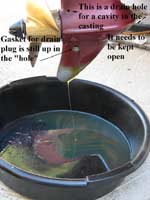
|
|
I already mentioned "running the gas out of
the engine," which means simply that the fuel
supply is cut off (remote tank hose disconnected/
fuel valve on internal tank closed) and the engine
is run until it runs out of gas. This will empty the
carburetor of most (but not all) gasoline. Gasoline
allowed to sit in a carburetor for months can partially
evaporate, leaving behind a gummy mess that require
one to dissasemble and clean the carb. Another concern
with the new ethanol-laden fuels is that the ethanol
may attack the varnished cork floats used in the carbs
of these engines. While running the gas out is a good
idea, a better idea is to run the gas out, and then
remove a tiny plug that most of these old OMC outboards
have on the bottom of the carb float bowl so that
the bowl can completely drain. Be sure to reinstall
the plug.
While it has always been recommended that one use
a fuel "stabilizer" additive in gasoline
that one intended to store for long periods of time,
say over the winter, I am now seeing recommendations
that one ALWAYS use the stabilizer, due to the relatively
short "shelf life" of the new ethanol-laden
gasolines. Although I am not currently using a stabilizer
for short-term storage of gasoline, I occasionally
need to learn lessons the "hard way."
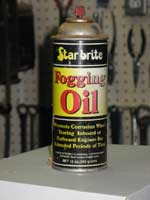 |
As I said,
I never "fog" my engines. I
had to search the whole shop to come up
with a can of fogging oil to get a photo
of. Found this can in the spider webs
under the workbench. If you run your engine
on oil/gas mixtures that are leaner than
I use, fogging your engine might be a
good idea.
|
|
That about covers winterization. The main things
to remember are that the water jackets will not drain
if the engine is horizontal, and that the #1 rule
of outboard motor winter storage is changing the lower
unit lube.
Happy Motor'n
Max

click
here for a list of Columns by Max Wawrzyniak
|